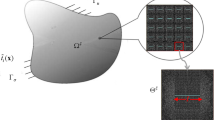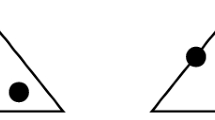Abstract
The understanding and the prediction of the failure behaviour of materials with pronounced microstructural effects is of crucial importance. This paper presents a novel computational methodology for the handling of fracture on the basis of the microscale behaviour. The basic principles presented here allow the incorporation of an adaptive discretization scheme of the structure as a function of the evolution of strain localization in the underlying microstructure. The proposed quasi-discrete methodology bridges two scales: the scale of the material microstructure, modelled with a continuum type description; and the structural scale, where a discrete description of the material is adopted. The damaging material at the structural scale is divided into unit volumes, called cells, which are represented as a discrete network of points. The scale transition is inspired by computational homogenization techniques; however it does not rely on classical averaging theorems. The structural discrete equilibrium problem is formulated in terms of the underlying fine scale computations. Particular boundary conditions are developed on the scale of the material microstructure to address damage localization problems. The performance of this quasi-discrete method with the enhanced boundary conditions is assessed using different computational test cases. The predictions of the quasi-discrete scheme agree well with reference solutions obtained through direct numerical simulations, both in terms of crack patterns and load versus displacement responses.














Similar content being viewed by others
References
Hettich T, Hund A, Ramm E (2008) Modeling of failure in composites by X-FEM and level sets within a multiscale framework. Comput Methods Appl Mech Eng 197:414
Nguyen V, Stroeven M, Sluys L (2012) Multiscale failure modeling of concrete: micromechanical modeling, discontinuous homogenization and parallel computations. Comput Methods Appl Mech Eng 201–204:139
van der Pluijm R (1999) Out-of-plane bending of masonry—behaviour and strength. Ph.D. thesis, Technische Universiteit Eindhoven
Smilauer V, Hoover C, Bazant Z, Caner F, Waas A, Shahwan K (2011) Multiscale simulation of fracture of braided composites via repetitive unit cells. Eng Frac Mech 78:901
Kouznetsova V, Geers M, Brekelmans W (2004) Multi-scale second-order computational homogenization of multi-phase materials: a nested finite element solution strategy. Comput Methods Appl Mech Eng 193:5525
Mercatoris B, Massart T (2009) Assessment of periodic homogenisation-based multiscale computational schemes for quasi-brittle structural failure. Int J Multiscale Comput Eng 7:153–170
Feyel F (2003) A multilevel finite element method (FE\(^2\)) to describe the response of highly non-linear structures using generalized continua. Comput Methods Appl Mech Eng 192:3233
Inglis H, Geubelle P, Matous K (2008) Boundary condition effects on multiscale analysis of damage localization. Philos Mag 88:2373
Coenen E, Kouznetsova V, Geers M (2010) Computational homogenization for heterogeneous thin sheets. Int J Numer Methods Eng 83:1180
Mercatoris B, Massart T (2011) A coupled two-scale computational scheme for the failure of periodic quasi-brittle thin planar shells and its application to masonry. Int J Numer Methods Eng 85:1177
Özdemir I, Brekelmans W, Geers M (2008) Computational homogenization for heat conduction in heterogeneous solids. Int J Numer Methods Eng 73:185
Coenen E, Kouznetsova V, Geers M (2012) Novel boundary conditions for strain localization analyses in microstructural volume elements. Int J Numer Methods Eng 90:1
Massart T, Peerlings R, Geers M (2005) A dissipation-based control method for the multi-scale modelling of quasi-brittle materials. C.R. Mécanique 333:521
Massart T, Peerlings R, Geers M (2007) An enhanced multi-scale approach for masonry walls computations with localisation of damage. Int J Numer Methods Eng 69:1022
Mesarovic S, Padbidri J (2005) Minimal kinematic boundary conditions for simulations of disordered microstructures. Philos Mag 85:65
Lloberas-Valls O, Rixen D, Simone A, Sluys L (2012) Multiscale domain decomposition analysis of quasi-brittle heterogeneous materials. Int J Numer Methods Eng 89:1337
Ghosh S, Lee K, Raghavan P (2001) A multi-level computational model for multi-scale damage analysis in composite and porous materials. Int J Solids Struct 38:2335
Ghosh S, Bai J, Raghavan P (2007) Concurrent multi-level model for damage evolution in microstructurally debonding composites. Mech Mater 39:241
Ladevèze P, Loiseau O, Dureisseix D (2001) A micro-macro and parallel computational strategy for highly heterogeneous structures. Int J Numer Methods Eng 51:121
Ibrahimbegovic A, Markovic D (2003) Strong coupling methods in multi-phase and multi-scale modeling of inelastic behavior of heterogeneous structures. Comput Methods Appl Mech Eng 192:3089
Magoulès F, Roux FX (2006) Lagrangian formulation of domain decomposition methods: a unified theory. Appl Math Model 30:593
Maday Y, Magoulès F (2006) Absorbing interface conditions for domain decomposition methods: a general presentation. Comput Methods Appl Mech Eng 195:3880
Farhat C, Roux FX (1991) A method of finite element tearing and interconnecting and its parallel solution algorithm. Int J Numer Methods Eng 32:1205
Garikipati K, Hughes T (1998) A study of strain localization in a multiple scale framework—the one-dimensional problem. Comput Methods Appl Mech Eng 159:193
Garikipati K, Hughes T (2000) A variational multiscale approach to strain localization—formulation for multidimensional problems. Comput Methods Appl Mech Eng 188:39
Kouznetsova V (2002) Computational homogenization for the multi-scale analysis of multi-phase materials, Ph.D. thesis, Technische Universiteit Eindhoven
Belytschko T, Loehnert S, Song JH (2008) Multiscale aggregating discontinuities: a method for circumventing loss of material stability. Int J Numer Methods Eng 73:869
Belytschko T, Song JH (2010) Coarse-graining of multiscale crack propagation. Int J Numer Methods Eng 81:537
Nguyen V, Lloberas-Valls O, Stroeven M, Sluys L (2011) Homogenization-based multiscale crack modelling: from micro-diffusive damage to macro-cracks. Comput Methods Appl Mech Eng 200:1220
Nguyen V, Stroeven M, Sluys L (2012) An enhanced continuous-discontinuous multiscale method for modeling mode-I cohesive failure in random heterogeneous quasi-brittle materials. Eng Frac Mech 79:78
Anthoine A (1995) Derivation of the in-plane elastic characteristics of masonry through homogenization theory. Int J Solids Struct 32:137
Michel J, Moulinec H, Suquet P (1999) Effective properties of composite materials with periodic microstructure: a computational approach. Comput Methods Appl Mech Eng 172:109
Lourenço P, Rots J (1997) Multisurface interface model for analysis of masonry structures. J Eng Mech 123:660
Page A (1978) Finite element model for masonry. J Struct Div ASCE 104:1267
Haach V, Vasconcelos G, Lourenço P (2011) Numerical analysis of concrete block masonry beams under three point bending. Eng Struct 33:3226
Acknowledgments
The first author was sponsored by the Fonds de la Recherche Scientifique F.R.S.-FNRS of Belgium (post-doctoral research grant ‘Chargè de Recherches’ No. 1.2.093.10.F). The authors also acknowledge the support of F.R.S.-FNRS Belgium (Grant No. 1.5.032.09.F) for the intensive computational facilities used for this work.
Author information
Authors and Affiliations
Corresponding author
Rights and permissions
About this article
Cite this article
Berke, P.Z., Peerlings, R.H.J., Massart, T.J. et al. A homogenization-based quasi-discrete method for the fracture of heterogeneous materials. Comput Mech 53, 909–923 (2014). https://doi.org/10.1007/s00466-013-0939-3
Received:
Accepted:
Published:
Issue Date:
DOI: https://doi.org/10.1007/s00466-013-0939-3




